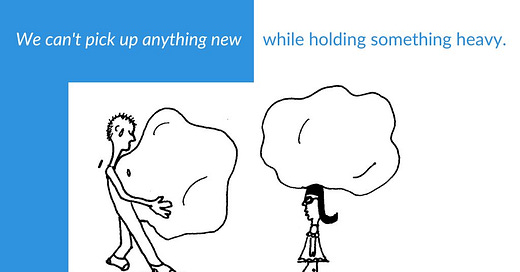"Being heard is so close to being loved, that for the average person, they are almost indistinguishable." - Dr. David Augsberger
Hi Friends,
Imagine that instead of tumbleweed tumbling by our wagons today on the belonging frontier, there are balloons with faces drawn on each in Sharpie. These balloons have bobbed downwind from a convening of Gen Z who decided to give hours of their rainy night to learn to become listening, healing presences in their worlds. To reverse polarization and its roots of fear and hate through real life conversations in their daily grinds.
Two weeks ago I had the joy of facilitating this unorthodox listening workshop sponsored by the Shoah Foundation and the Center for Political Future and organized by two stand-out USC seniors dedicated to social transformation. I showed up with a Barbie helicopter, plastic flamingo and balloons, as professionals do. I had enough listening activities to fill a 3-day conference because I don’t often know in advance what the needs and obstacles are for the participants (or their tolerance for weirdness.) I need options.
Turns out my balloon activity that was supposed to be a silly kick-off to the “real meat” of the training, took on a life of its own. I want to slow down the learnings from just this one activity to help us unpack the infinite world of listening that opens to us when we make any sincere, even awkward movement towards it.
Approaching abstract concepts and complex experiences of hate and love, fear and safety can be fraught if we start analytically. It helps to start from a tiny, creative, and joyful place through a low-risk bodily experience. With balloons and stories of people we love, not with arguments, research and depressing statistics.
Agency + banning gurus
I walked around to each person with a handful of colorful balloons to choose from. This mattered. It got me up close to each person with an offering and a nod to their agency to make even the smallest of choices. It also diminished the gross power distance created when someone in the room is positioned as a “guru”—we all need to be members in an ecosystem of wisdom where we are at all times both givers and receivers of wisdom.
Positive Memories + Regulating Our Nervous Systems
They were already sitting in groups of three, with one person they knew and one they didn’t. The instruction was to bring to mind someone from their life who has been a listening presence for them and to draw their face on the balloon and write their name on the back. As they drew, they would share together how these balloon people had affected their lives.
Further, our amazing nervous systems regulate when we call to mind positive experiences of feeling safe, connected and known. From a space of regulation, we are poised to take risks in opening up to new people, examining our own perspectives, and staying aligned to our goals and values. When there’s joy brought in as well, we activate what neuroscientists call “the joy switch” in our brains that bring our “relational circuitry” online to poise us for positive interactions.
The centrality of faces
Specifically holding our attention on the details of someone’s face in the act of drawing not only deepens our ability to attend to each other—a core social-emotional competence, but also reconnects us to the most ancient source of identity-formation: our caretaker’s face. Developmental psychologists state that much of our sense of selfhood is set in the first two years of life through the attachment we form with our caretaker. This attachment is largely woven from face to face thousands of times per second. Into adolescence and adulthood we continue to search each other’s faces —the micro-expressions common across cultures—for an answer to our deepest question, “Do you want to be with me?”
Adding “air” in conversations
Providing something to “do” while having a conversation inserts “air” into the sharing dynamic. This invites those who like to connect by doing things side-by-side instead of face-to-face to have a place to thrive. It also invites those of us with social anxiety, introversion, certain traumas to more freely engage. With more “air” there’s less pressure on direct eye contact and advanced conversational dynamics, which also supports those of us with certain kinds of autism and language familiarity to thrive. And the more intense or volatile a conversation, the more need for air.
Cherishing artifacts in the screen age
The students took their balloon faces home, funny physical reminders of both who has been there for them in their lives and also who they’re deciding to become. They also took home the imprint of the faces of their peers looking at them with interest and kindness as they honored their balloon person aloud.
I don’t remember what else we covered in the session, but I do know that the students walked away with profound personal, academic, and vocational next steps that emerged from this crazy balloon experience. I walked away with a plan to start a listening workshop series that never ends. Maybe it’ll be called Listening to Infinity and Beyond:)
Sending balloons and Sharpies from the frontier,
Cat



